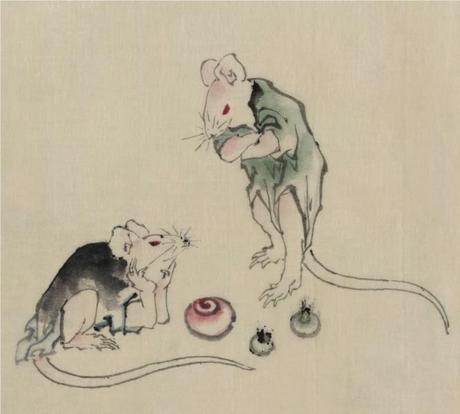
Two Mice by Hokusai
Recently a friend sent me a link to this video on stress by Dr. Kelly McGonigal because she thought I might find it interesting. Well, I started to watch it thinking I might share it on Facebook, but I was so troubled by what Dr. McGonigal said during the first minute that I switched it off. What Dr. McGonigal said—and perhaps she was just being dramatic—was that she had entirely changed her mind about how stress affects our health because of a study she read that showed that people only got sick from stress when they believed that stress was bad for them.I just found that hard to believe! Now I know Kelly’s a Stanford psychologist and all, but I’ve been married to a scientist for a very long time so I tend to be very skeptical about some of these types of studies. So I decided to do a reality check with said scientist (for our newer readers, that would be Brad Gibson, a medical researcher at the Buck Institute for Research on Aging). I told him about what she claimed, and asked if that was possible.
“It’s BS,” he said firmly. “After all, most of the studies on the effects of stress have been done on mice.”
I understood his point: they didn’t exactly divide the mice into two groups, one who they told that stress was bad for mice and the other who they just stressed out without telling them that stress was bad.
And just as I was starting to wonder how you stress out a mouse, he said, “For example, in some studies they make it impossible for a mouse to create its little nest.”
I thought that was fascinating—a mouse needs to go off by itself for periods of time into its cozy little place in order to stay sane.
Brad went on, “If they disrupt a mouse’s ability to nest, it becomes very stressed out and there are obvious chemical changes they can measure. If they continue the disruption for only a short period of time, the mouse’s chemical balance will return to normal. However, if this goes on for a very long period of time, the imbalance can become permanent.”
Well, we’ve been talking on this blog about the negative effects of chronic stress since the early days (see Chronic Stress: An Introduction and Stress, Your Health and Yoga). But what this particular story about the experiments on mice made me think of was my own yoga practice. Yes, my regular home practice is my refuge, not unlike the little nest a mouse makes for itself to retreat to. Spending that quiet time alone, feeling my body and my breath, almost never fails to make me feel better than before I practice. And when I am experiencing stressful events—that is unavoidable of course, and maybe the point Kelly McGonigal was trying to get to—I tailor my practice to calm and comfort myself. And this yoga as a "refuge" concept is one of the main reasons I’m on a mission to encourage people to start practicing yoga at home, even just for short sessions.
Restorative yoga in particular, with all the blankets and pillows and comfy bolsters, is a little bit like nesting, isn’t it? If you’re not familiar with restorative yoga, read Restorative Yoga: An Introduction and see Mini Restorative Practice for a mini restorative practice that is suitable for most everyone. Even just a brief session of Supported Child’s pose can be extremely calming and comforting.


